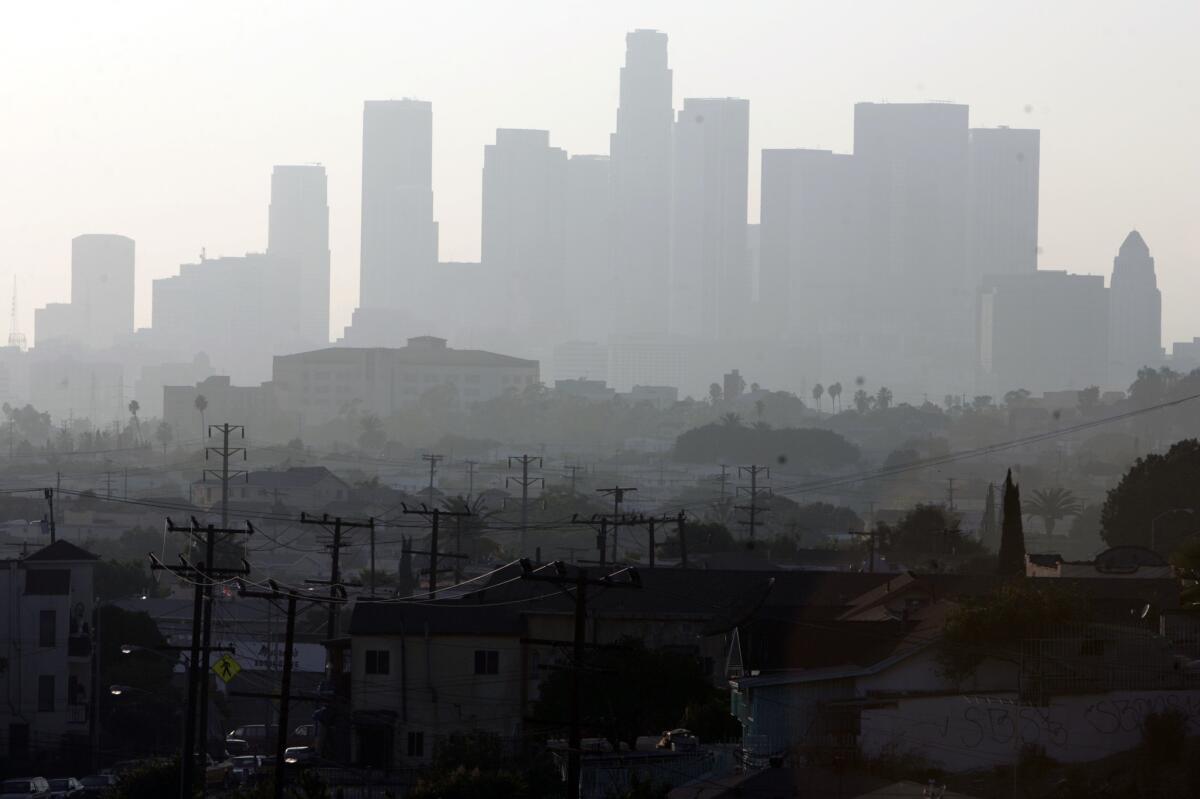Climate change could worsen ozone levels across the U.S., study says

- Share via
Smog could worsen across the United States in the coming decades as climate change boosts summer temperatures and makes ozone levels more difficult to control, a new study says.
Americans can expect the number of days with unhealthy air to jump 70% by mid-century unless emissions of smog-forming pollutants are slashed, according to a study led by the federally funded National Center for Atmospheric Research in Boulder, Colo.
Higher temperatures accelerate the formation of lung-searing ozone, the main ingredient of smog, and could set back decades of improvements in air quality, the study says.
“It will hinder our progress,” said Gabriele Pfister, a scientist at NCAR and lead author of the study published this week.
Pollution regulators, however, could keep the warming climate from degrading air quality if they adopt stringent emissions controls, the research showed.
To reach their conclusions, scientists used a supercomputer to simulate pollution levels across the country as the planet warms.
They found a widespread increase in the number of days above federal health standards for ozone by 2050 if emissions of smog-forming pollutants, including nitrogen oxides and volatile organic compounds, remain at their current levels.
Under that scenario, almost the entire continental U.S. would have at least a few days of unhealthy air a year while the most heavily polluted metropolitan areas would see ozone levels exceed health standards for most of the summer, the research shows.
Cutting smog-forming emissions by 60% to 70% however, would achieve big reductions in ozone pollution even as the climate warms, the analysis found, with the number of days above federal health standards falling to below 1% of current levels.
“If we can really cut back on our local emissions then we can clean up our air,” Pfister said.
The link between higher temperatures and ozone was already known, but Pfister said it was the first fine-grain analysis of how the warming climate could affect air quality in all regions of the country.
Ozone is a harmful gas that forms when pollutants from vehicle tailpipes, power plants and factories react in sunlight. Heat speeds up those reactions, so it will become increasingly difficult to keep ozone levels in check as temperatures rise from the human-caused buildup of greenhouse gases in the atmosphere.
Contributing to the problem is methane, a greenhouse gas emitted by oil and gas activity, landfills and livestock that is contributing to higher ozone levels globally. Higher temperatures also cause plants to release more volatile organic compounds, which can boost smog formation when they mix with man-made pollutants.
Ozone can inflame and damage the airways, trigger respiratory problems and aggravate asthma and bronchitis. Children are at the highest risk from ozone pollution because their lungs are still developing.
Current federal health standards limit concentrations of ozone to 75 parts per billion over an 8-hour period.
Based on robust scientific evidence that ozone is harmful at lower levels than previously thought, the U.S. Environmental Protection Agency is considering stricter health standards that would force state and local regulators to make further emissions cuts.
Recent reports by local air agencies and the American Lung Assn. have also warned of the effects of climate change on smog, particularly in California, where residents of Greater Los Angeles and the San Joaquin Valley breathe the dirtiest air in the nation.
Twitter: @tonybarboza







